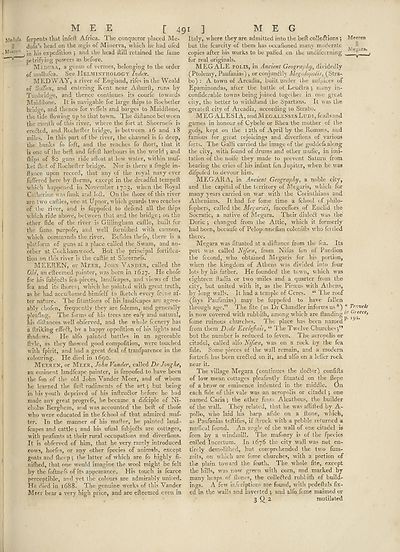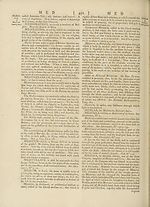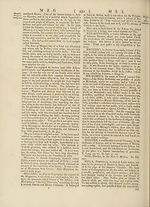Encyclopaedia Britannica, or, a Dictionary of arts, sciences, and miscellaneous literature : enlarged and improved. Illustrated with nearly six hundred engravings > Volume 13, MAT-MIC
(533) Page 491
Download files
Complete book:
Individual page:
Thumbnail gallery: Grid view | List view

M E E [ 49i ] MEG
Medufa ferpents that infeft Africa. The conqueror placed Me¬
lt dufa’s head on the aegis of Minerva, which he had ufed
1 Mceren jn eXpedition j and the head flill retained the fame
" v 1 petrifying powers as before.
Medusa, a genus of vermes, belonging to the order
of mollufca. See Helminthology Index.
MED WAY, a river of England, rifes in the Weald
of Suffex, and entering Kent near Aihurft, runs by
Tunbridge, and thence continues its courfe towards
Maidftone. It is navigable for large Ihips to Roeheiter
bridge, and thence for veflels and barges to Maidftone,
the tide flowing up to that town. The diftance between
the mouth of this river, where the fort at Siieernefs is
erected, and Rochefter bridge, is between 16 and 18
miles. In this part of the river, the channel is fo deep,
the banks fo foft, and the reaches fo ftiort, that it
R one of the beft and fafeft harbours in the world ; and
drips of 80 guns ride afloat at low water, within muf-
ket (hot of Rocheftcr bridge. Nor is there a Angle in-
ftance upon record, that any of the royal navy ever
fuffered here by ftorms, except in the dreadful tempeft
which happened in November 1703, when the Royal
Catherine was funk and loft. On the (bore of this river
are two caftles, one at Upnor, which guards two reaches
of the river, and is fuppofed to defend all the Ihips
which ride above, between that and the bridge; on the
other fide of the river is Gillingham caftle, built for
the fame purpofe, and well furnithed with cannon,
which commands the river. Befides thefe, there is a
platform of guns at a place called the Swam, and an¬
other at Cockhamwood. But the principal fortifica¬
tion on tills river is the caftle at Siieernefs.
MEEREN, or Meer, John Vander, called the
Old, an eftcemed painter, was born in 1627- c^°^e
for his fubjedls fea-pieces, landfcapes, and views of the
fea and its fliores; which he painted with great truth,
as he had accuftomed himfelf to Iketch every fecne af¬
ter nature. The fituations of his landfcapes are agree¬
ably chofen, frequently they are folemn, and generally
pleafing. The forms of his trees are eafy and natural,
his diftances well obferved, and the whole feenery has
a linking effedl, bv a happy oppofition of his lights and
fhadows. He alfo painted battles in an agreeable
ftvle, as they fliowed good eompofition, were touched
with fpirit, and had a great deal of tranfparence in the
colouring. He died in 1690.
M EE REN, or Meer, John Vander, called De Jong he,
an eminent landfcape painter, is fuppofed to have been
the fon of the old John Vander Meer, and of whom
he learned the firft rudiments of the art ; but being
in his youth deprived of his inftruftor before he had
made anv great progrefs, he became a difciple of Ni¬
cholas Berghem, and was accounted the beft of tbofe
who were educated in the fchool of that admired maf-
ter. In the manner of his mafter, he painted land¬
fcapes and cattle ; and his ufual fubjefts are cottages,
with peafants at their rural occupations and diverfions.
It is obferved of him, that he very rarely introduced
cows, horfes, or any other fpecies of animals, except
goats and fheep •, the latter of which are fo highly fi-
nilhed, that one would imagine the wool might be felt
by the foftnefs of its appearance. Elis touch is fcarce
perceptible, and yet the colours are admirably united.
He died in 1688. The genuine works of this Vander
Mcer bear a very high price, and are efteemed even in
Italy, where they are admitted into the beft colle£Hons ; Meeren
but the fcarcity of them has occafioned many moderate H
copies after his works to be palled on the undifeerning
for real originals.
MEG ALE polis, in Ancient Geography, dividedly
(Ptolemy, Paufanias) , or conjuntftly Megalopolis, (Stra¬
bo) : A town of Arcadia, built under the aufpices of
Epaminondas, after the battle of Leuclra ; many in-
conliderable towns being joined together in one great
city, the better to withftand the Spartans. It was the
greateft city of Arcadia, according to Strabo.
MEG ALESI A, and Meg alenses Ludi, feaftsand
games in honour of Cybele or Rhea the mother of the
gods, kept on the 1 2th of April by the Romans, and
famous for great rejoicings and diverftons of various
forts. The Galii carried the image of the goddefs along
the city, with found of drums and oilier mufic, in imi¬
tation of the noife they made to prevent Saturn from
hearing the cries of his infant fon Jupiter, -when he was
difpofed to devour him.
MEGARA, in Ancient Geography, a noble city,
and the capital of the territory of Megaris, which for
many years carried on war with the Corinthians and
Athenians. It had for fome time a fchool of philo-
fophers, called the Megarici, fucceffors of Euclid the
Socratic, a native of Megara. Their dialed! was the
Doric ; changed from the Attic, which it formerly
had been, becaufe of Peloponnefian colonifts who fettled
there.
Megara was fituated at a diftance from the fea. Its
port was called Nifeca, from Nifus fon of Pandion
the fecond, who obtained Megaris for his portion,
when the kingdom of Athens was divided into four
lots by his father. He founded the town, which was
eighteen ftadia or two miles and a quarter from the
city, but united with it, as the Pineus with Athens,
by long walls. It had a temple of Ceres. “ The roof
(fays Paufanias) may be fuppofed to have fallen
through age.” The fite (as Dr Chandler informs us*) * Travels
is now covered with rubbifti, among which are Handing z' ^ieece>
fome ruinous churches. The place has been named ^ ^
from them D aIc Ecclejiais, “ The Twelve Churches
but the number is reduced to feven. The acropolis or
citadel, called alfo Nifeea, was on a rock by the fea
fide. Some pieces of the wall remain, and a modem
fortrefs has been eredied on it, and alfo on a leffer rock
near it.
The village Megara (continues the dodlor) confifts
of low mean cottages pleafantly fituated on the flope
of a brow or eminence indented in the middle. On
each fide of this vale was an acropolis or citadel ; one
named Cana ; the other from Alcathous, the builder
of the wall. They related, that he was aflifted by A-
pollo, who laid his harp afide on a ftone, which,
as Paufanias teftifies, if ftruck with a pebble returned a
mufical found. An angle of ihe wall of one citadel is
feen by a windmill. The mafonry is of the fpecies
called Incertum. In 1676 the city wall was not en¬
tirely demoliftied, but comprehended the two fum-
mits, on which are fome churches, with a portion of
the plain toward the fouth. The whole fite, except
the hills, was now green with corn, and marked by
many heaps of ftones, the collefted rubtifh of build¬
ings. A few inferiptions arc found, with pedeftals fix¬
ed in the walls and inverted ; and alfo.. fome maimed or
3 Q 2 mutilated
Medufa ferpents that infeft Africa. The conqueror placed Me¬
lt dufa’s head on the aegis of Minerva, which he had ufed
1 Mceren jn eXpedition j and the head flill retained the fame
" v 1 petrifying powers as before.
Medusa, a genus of vermes, belonging to the order
of mollufca. See Helminthology Index.
MED WAY, a river of England, rifes in the Weald
of Suffex, and entering Kent near Aihurft, runs by
Tunbridge, and thence continues its courfe towards
Maidftone. It is navigable for large Ihips to Roeheiter
bridge, and thence for veflels and barges to Maidftone,
the tide flowing up to that town. The diftance between
the mouth of this river, where the fort at Siieernefs is
erected, and Rochefter bridge, is between 16 and 18
miles. In this part of the river, the channel is fo deep,
the banks fo foft, and the reaches fo ftiort, that it
R one of the beft and fafeft harbours in the world ; and
drips of 80 guns ride afloat at low water, within muf-
ket (hot of Rocheftcr bridge. Nor is there a Angle in-
ftance upon record, that any of the royal navy ever
fuffered here by ftorms, except in the dreadful tempeft
which happened in November 1703, when the Royal
Catherine was funk and loft. On the (bore of this river
are two caftles, one at Upnor, which guards two reaches
of the river, and is fuppofed to defend all the Ihips
which ride above, between that and the bridge; on the
other fide of the river is Gillingham caftle, built for
the fame purpofe, and well furnithed with cannon,
which commands the river. Befides thefe, there is a
platform of guns at a place called the Swam, and an¬
other at Cockhamwood. But the principal fortifica¬
tion on tills river is the caftle at Siieernefs.
MEEREN, or Meer, John Vander, called the
Old, an eftcemed painter, was born in 1627- c^°^e
for his fubjedls fea-pieces, landfcapes, and views of the
fea and its fliores; which he painted with great truth,
as he had accuftomed himfelf to Iketch every fecne af¬
ter nature. The fituations of his landfcapes are agree¬
ably chofen, frequently they are folemn, and generally
pleafing. The forms of his trees are eafy and natural,
his diftances well obferved, and the whole feenery has
a linking effedl, bv a happy oppofition of his lights and
fhadows. He alfo painted battles in an agreeable
ftvle, as they fliowed good eompofition, were touched
with fpirit, and had a great deal of tranfparence in the
colouring. He died in 1690.
M EE REN, or Meer, John Vander, called De Jong he,
an eminent landfcape painter, is fuppofed to have been
the fon of the old John Vander Meer, and of whom
he learned the firft rudiments of the art ; but being
in his youth deprived of his inftruftor before he had
made anv great progrefs, he became a difciple of Ni¬
cholas Berghem, and was accounted the beft of tbofe
who were educated in the fchool of that admired maf-
ter. In the manner of his mafter, he painted land¬
fcapes and cattle ; and his ufual fubjefts are cottages,
with peafants at their rural occupations and diverfions.
It is obferved of him, that he very rarely introduced
cows, horfes, or any other fpecies of animals, except
goats and fheep •, the latter of which are fo highly fi-
nilhed, that one would imagine the wool might be felt
by the foftnefs of its appearance. Elis touch is fcarce
perceptible, and yet the colours are admirably united.
He died in 1688. The genuine works of this Vander
Mcer bear a very high price, and are efteemed even in
Italy, where they are admitted into the beft colle£Hons ; Meeren
but the fcarcity of them has occafioned many moderate H
copies after his works to be palled on the undifeerning
for real originals.
MEG ALE polis, in Ancient Geography, dividedly
(Ptolemy, Paufanias) , or conjuntftly Megalopolis, (Stra¬
bo) : A town of Arcadia, built under the aufpices of
Epaminondas, after the battle of Leuclra ; many in-
conliderable towns being joined together in one great
city, the better to withftand the Spartans. It was the
greateft city of Arcadia, according to Strabo.
MEG ALESI A, and Meg alenses Ludi, feaftsand
games in honour of Cybele or Rhea the mother of the
gods, kept on the 1 2th of April by the Romans, and
famous for great rejoicings and diverftons of various
forts. The Galii carried the image of the goddefs along
the city, with found of drums and oilier mufic, in imi¬
tation of the noife they made to prevent Saturn from
hearing the cries of his infant fon Jupiter, -when he was
difpofed to devour him.
MEGARA, in Ancient Geography, a noble city,
and the capital of the territory of Megaris, which for
many years carried on war with the Corinthians and
Athenians. It had for fome time a fchool of philo-
fophers, called the Megarici, fucceffors of Euclid the
Socratic, a native of Megara. Their dialed! was the
Doric ; changed from the Attic, which it formerly
had been, becaufe of Peloponnefian colonifts who fettled
there.
Megara was fituated at a diftance from the fea. Its
port was called Nifeca, from Nifus fon of Pandion
the fecond, who obtained Megaris for his portion,
when the kingdom of Athens was divided into four
lots by his father. He founded the town, which was
eighteen ftadia or two miles and a quarter from the
city, but united with it, as the Pineus with Athens,
by long walls. It had a temple of Ceres. “ The roof
(fays Paufanias) may be fuppofed to have fallen
through age.” The fite (as Dr Chandler informs us*) * Travels
is now covered with rubbifti, among which are Handing z' ^ieece>
fome ruinous churches. The place has been named ^ ^
from them D aIc Ecclejiais, “ The Twelve Churches
but the number is reduced to feven. The acropolis or
citadel, called alfo Nifeea, was on a rock by the fea
fide. Some pieces of the wall remain, and a modem
fortrefs has been eredied on it, and alfo on a leffer rock
near it.
The village Megara (continues the dodlor) confifts
of low mean cottages pleafantly fituated on the flope
of a brow or eminence indented in the middle. On
each fide of this vale was an acropolis or citadel ; one
named Cana ; the other from Alcathous, the builder
of the wall. They related, that he was aflifted by A-
pollo, who laid his harp afide on a ftone, which,
as Paufanias teftifies, if ftruck with a pebble returned a
mufical found. An angle of ihe wall of one citadel is
feen by a windmill. The mafonry is of the fpecies
called Incertum. In 1676 the city wall was not en¬
tirely demoliftied, but comprehended the two fum-
mits, on which are fome churches, with a portion of
the plain toward the fouth. The whole fite, except
the hills, was now green with corn, and marked by
many heaps of ftones, the collefted rubtifh of build¬
ings. A few inferiptions arc found, with pedeftals fix¬
ed in the walls and inverted ; and alfo.. fome maimed or
3 Q 2 mutilated
Set display mode to:
![]() Universal Viewer |
Universal Viewer | ![]() Mirador |
Large image | Transcription
Mirador |
Large image | Transcription
Images and transcriptions on this page, including medium image downloads, may be used under the Creative Commons Attribution 4.0 International Licence unless otherwise stated. ![]()
| Permanent URL | https://digital.nls.uk/192668091 |
|---|
| Attribution and copyright: |
|
|---|
| Description | Ten editions of 'Encyclopaedia Britannica', issued from 1768-1903, in 231 volumes. Originally issued in 100 weekly parts (3 volumes) between 1768 and 1771 by publishers: Colin Macfarquhar and Andrew Bell (Edinburgh); editor: William Smellie: engraver: Andrew Bell. Expanded editions in the 19th century featured more volumes and contributions from leading experts in their fields. Managed and published in Edinburgh up to the 9th edition (25 volumes, from 1875-1889); the 10th edition (1902-1903) re-issued the 9th edition, with 11 supplementary volumes. |
|---|---|
| Additional NLS resources: |
|

